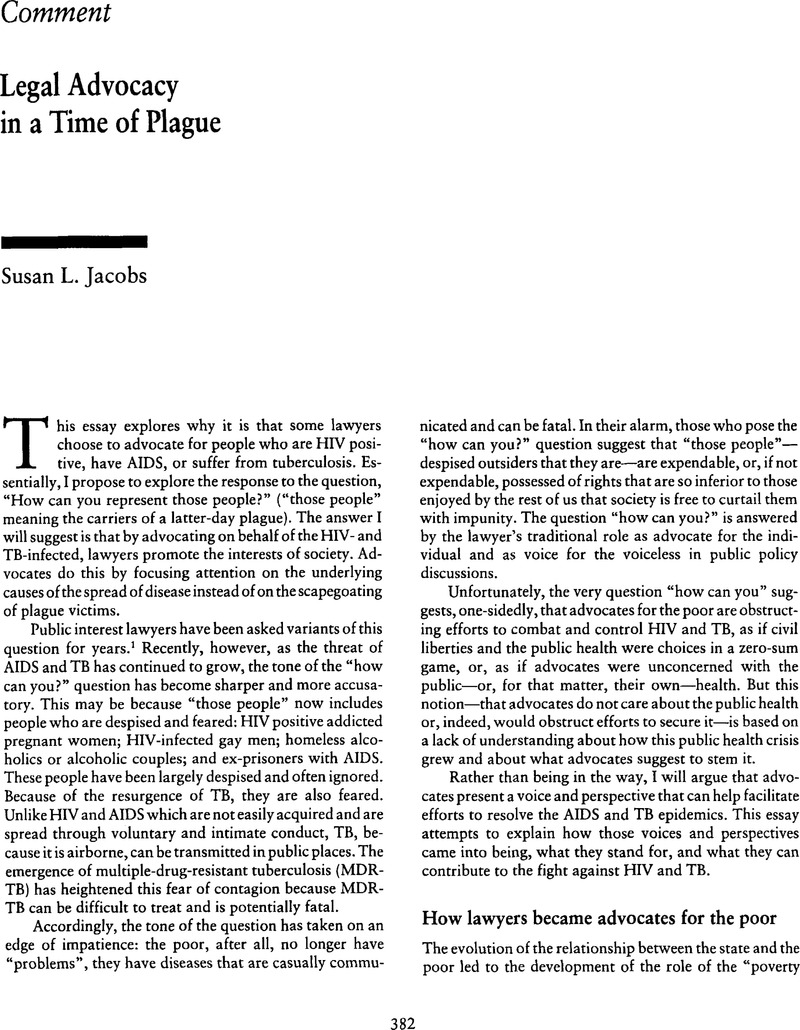No CrossRef data available.
Article contents
Legal Advocacy in a Time of Plague
Published online by Cambridge University Press: 01 January 2021
Abstract
An abstract is not available for this content so a preview has been provided. Please use the Get access link above for information on how to access this content.

- Type
- Comment
- Information
- Copyright
- Copyright © American Society of Law, Medicine and Ethics 1993
References
The author gratefully acknowledges the support of her family and her colleagues at the Legal Action Center especially Felix Lopez, Esq. and Robb Cowie for their editorial assistance and support and Catherine Harries, Law Intern. The author also acknowledges the members of the NYC TB Working Group for their collective contributions and wisdom.Google Scholar
Kunen, James S., “How Can You Defend Those People?”: The Making of a Criminal Lawyer (1983).Google Scholar
Rothman, David J., “The State As Parent: Social Policy in the Progressive Era,” in Gaylin, et al., eds., Doing Good, The Limits of Benevolence (1978):67 [hereinafter Rothman].Google Scholar
Id. at 69–70.Google Scholar
Goffman, Erving, Asylums 16 (1961). Goffman compares asylums to prisons where “[t]he inmate cannot easily escape from the press of judgmental officials and from the enveloping tissue of restraint,” quoted in Glasser, Ira, “Prisoners of Benevolence, Power Versus Liberty in the Welfare State,” in Gaylin, et al., eds., Doing Good, The Limits of Benevolence (1978): 99, 111–112.Google Scholar
Glasser, , supra, at 105–106.Google Scholar
Patterson, Elizabeth G., “Health Care Choice and the Constitution: Reconciling Privacy and Public Health,” Rutgers L. Rev., 42 (1989).Google Scholar
For example, in Florida, cases of AIDS, STD's and TB must be reported to the Department of Health and Rehabilitative Services county public health unit. F.A.C. Rules 10D-3.097(3), (5), 10D-3.105(1) and 10d-3.098(l)(b)(2). Florida authorizes personal restriction, isolation and compulsory outpatient or inpatient treatment of persons with STDs, Fla. Stat. §§ 384.27, 384.28, and partner tracing and contact in reported cases of STD's and AIDS. Fla. Stat. § 384.26. Florida also authorizes compulsory treatment and hospitalization of persons with TB, FAC Rule 10D-3.109.Google Scholar
See, for example, In Re Halko, 246 Cal. App.2d 553, 54 Cal.Rptr. 661 (Ct. App. 1966) (permitting indefinite confinement of a tubercular patient); People of State of Illinois v. C.S., 222 Ill. App.3d 348, 583 N.E.2d 726 (1991) (authorizing mandatory HIV testing and disclosure for persons convicted of unauthorized possession of a syringe). Allen v. Ingalls, 182 Ark. 991, 33 S.W.2d 1099 (1931) (emergency not necessary to justify immunization). Irwin v. Arrendale, 159 S.E.2d 719, 724 (GA. Appeal 1967) (state may order mandatory X-ray as part of infectious disease examination).Google Scholar
See, for example, Carlon, Cynthia A., “Tuberculosis Control: Will the Legal System Guard Our Health and Will the ADA Hamper Our Control Efforts?” J. Legal Med., 13 (1992): 563.CrossRefGoogle Scholar
Not long ago, a New York City Department of Health task force issued a draft report recommending the adoption of measures to facilitate the widescale detention of “chronically non-compliant TB patients.” New York City Department of Health, Draft Report (Spring 1992). The report asserted that it was necessary to rehabilitate certain TB patients in secure facilities. The task force proposed several possible detention sites, including “secure” drug treatment programs, nursing homes, “secure” TB shelters, and mental health facilities. The report, which was criticized extensively for focusing on containing the victim, not the disease, was retracted, to the city's credit. See also, Mahon, et al., New York City TB Working Group, “Developing a System for TB Prevention and Care in New York City,” (September 1992) [hereinafter TB Working Group].Google Scholar
See Wallace, , “A Synergism of Plagues: “Planned Shrinkage”, Contagious Housing Destruction, and AIDS in the Bronx,” Environmental Research 47 (1988): 1.CrossRefGoogle Scholar
Personal communication to author from M. Isbell and TB Working Group, see also, “Developing a System for TB Prevention and Care in New York City,” supra note 10.Google Scholar
New York City Department of Health, “Tuberculosis (TB) Blueprint: Goals and Objectives” (Draft, October 8, 1992).Google Scholar
TB Working Group, pp. 24–15.Google Scholar
TB Working Group, p. 25.Google Scholar
See n. 13, supra.Google Scholar
TB Working Group, p. 19.Google Scholar
King, Geis, “Tuberculosis Transmission in a Large Urban Jail,” JAMA 237 (1977): 791; see also Abeles, et al., “The Large City Prison: A Reservoir of Tuberculosis,” Am. Rev. Respiratory Disease, 101 (1970): 706.CrossRefGoogle Scholar
Powell v. Alabama, 287 U.S. 45 (1932). See also, Gideon v. Wainwright, 372 U.S. 335 (1963). For a discussion of the due process requirements in civil commitment proceedings, see Duizend, et al., “An Overview of State Involuntary Commitment Statutes,” Mental & Personality Disability L. Rep., 8 (1984): 328Google Scholar
N.Y. City Health Code § 11.47(d)(4).Google Scholar
TB Working Group, supra note 10, at 33.Google Scholar




